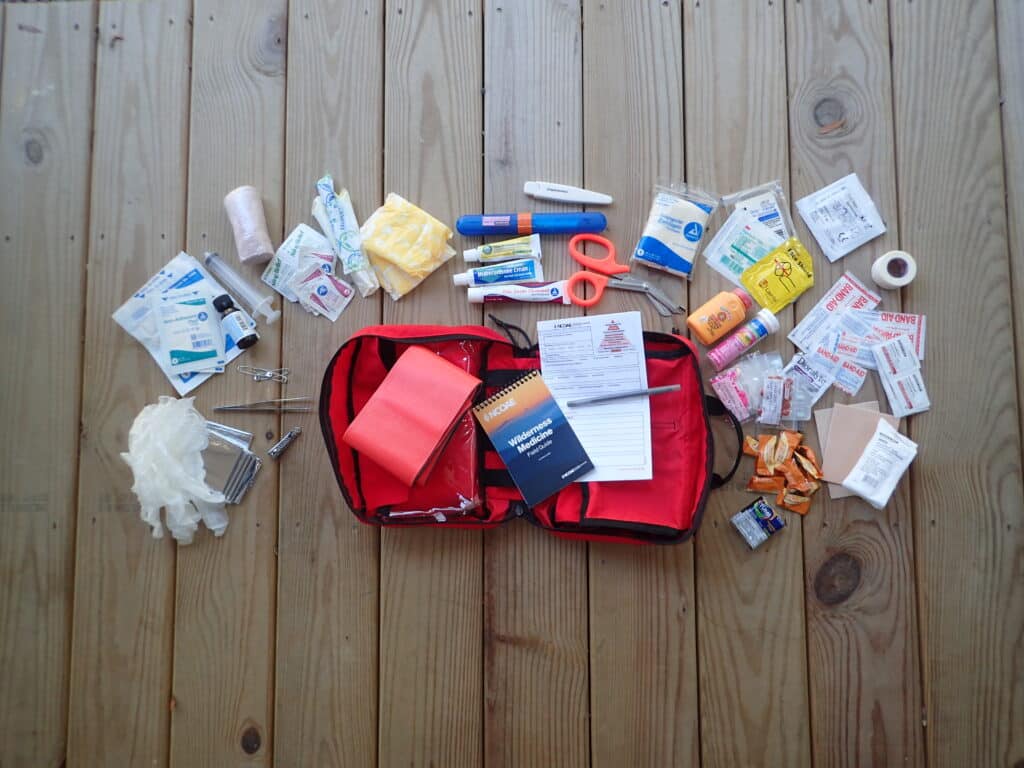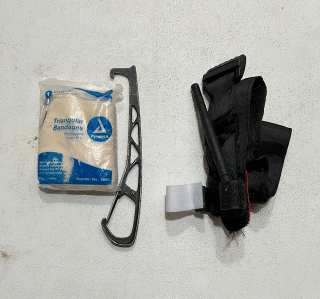Backcountry and wilderness expeditions and daytrips can be a blast! One minute you’re stimulated by the views and having fun, and in some instances, the next minute you’re on the ground after tripping on a rock, asking yourself, “Where did all that blood come from?”
Having the right medical supplies can turn a potential disaster into just another compelling campfire story. The question is, what medical supplies are the right ones? What items should you carry in your adventure-based first aid kit? What do you need and what can you do without?

The answers to those questions are elusive, and for good reason; they vary based on several factors, including the following:
- The terrain you plan to traverse (forest, mountains, wetlands, etc.)
- The activities you’ll engage in (hiking, climbing, kayaking, etc.)
- Group size and composition (for example, if someone in your party has a history of bleeding or suffers severe allergic reactions)
- Trip length (time and distance)
In this post, I provide some general guidance on what items to include in your first aid kit, along with other points to ponder as you plan ahead for unexpected injuries and illnesses.
First Aid Kit or Boo Boo Bag?
The first decision you need to make is whether you’re packing a lifesaving focused first aid kit or a boo boo bag:
- A first aid kit (FAK) may contain potentially lifesaving items, such as hemostatic gauze pads (to stop bleeding), a space blanket (to prevent hypothermia), and a ventilation mask (for safely delivering mouth-to-mouth resuscitation), among the essentials.
- A boo boo bag contains items for treating minor injuries and alleviating pain; for example, it may contain band-aids, antiseptic wipes, and aspirin or acetaminophen, among others elements.
Often a team carries a first aid kit for moderate to severe injuries and illnesses while individuals carry their own boo boo bags, along with any items they need for their specific medical needs, such as an EpiPen (to treat a severe allergic reaction) or prescription medications. In the case of prescription medications, expeditions involving underage youth tend to place the medication in the care of a field guide who is trained on timing and administration.
The Three Cs of Packing a First Aid Kit
When you’re deliberating what to pack, we recommend exploring the three Cs of packing a medical first aid kit:
- Comprehension: Pack only those items you understand and know how to use. For example, if you don’t know how to use a snake bite kit, either learn how it works or don’t pack one.
- Container: Consider the container you’re going to use to hold your medical supplies. If you need to pack items that can’t get wet, be sure your container is waterproof. Also consider the size of your kit; do you need it to be small enough to fit in your pocket, or are you setting aside space in your backpack or kayak?
- Contents: What you pack all boils down to the contents. But as I mentioned earlier in this post, contents can vary a great deal, especially if you’re skilled at improvising a specific item, as explained in the next section.
Pack or Improvise?
Depending on how resourceful you are, you may be able to limit your first aid supplies to the bare necessities, knowing that, in a pinch, you can fashion supplies or equipment out of other materials. Consider breaking down your first aid and medical supplies into the following two categories:
- Specialized manufactured items: These are items you purchase and pack that typically have a specific medical use and remain in the kit until the need arises; for example, a space blanket, a tourniquet, band aids, and gauze.
- Improvised items: These items are used primarily as part of the activity being performed and can act as medical equipment if necessary. For example, you can cut up a T-shirt to use as gauze, use a sleeping bag as a space blanket, or fashion a tourniquet out of a bandana and a stick.
The photo below shows two options for a tourniquet. The manufactured tourniquet (on the right) is specifically designed for that purpose. However, the rock-climbing stopper tool and triangle bandage (shown on the left), work quite well as a tourniquet and have multiple other uses.
Packing Lifesaving Essentials
When asked what first aid items to pack for a wilderness adventure, Baloo the bear from The Jungle Book film, would likely advise that all you really need are the “bare necessities.” But what would constitute the bare necessities in wilderness medicine? One way to look at it is to consider the injuries and illnesses that are most likely to cause death or permanent disability:

- Blood loss: You need to be able to stop any severe bleeding. You can do this with a tourniquet (manufactured or improvised), direct pressure, wound packing, and standard or hemostatic gauze.
- Inability to breathe: A person breathing inadequately will certainly die without assistance. To provide CPR safely, you should use a CPR mask, but if you don’t have one, you may decide to provide mouth-to-mouth resuscitation or use a bandana or some other improvised device to protect yourself.
- Hypothermia: Icy waters or weather, especially in the event of trauma is deadly. You could carry a space blanket and chemical hot packs or rely on extra layers from the group and use a stove to heat hot water bottles.
Lifesaving essentials may also include prescription medications, such as an EpiPen, insulin for patients with diabetes, blood pressure medication, and so on. Make sure everyone in your party has the prescription medications they need.
Considering Optional Items
In addition to packing the bare essentials for preserving life and limb, consider packing the following optional items:
- SAM splints: SAM stands for structural aluminum malleable. These come in rolls that you can wrap around a limb or joint (like a cast) to immobilize it.
- Pain relievers: Motrin and Tylenol are very effective pain medications. Aspirin can come in handy in the event of a suspected heart attack.
- Antiseptics: Antiseptic wipes and ointments can be used to clean and dress wounds and prevent infection.
- Antihistamines: Over-the-counter medications such as Benadryl and Zyrtec can come in handy for insect bites and stings and other mild allergic reactions.
- Tweezers: Tweezers are essential for removing splinters (because let’s face it, even a tiny splinter can ruin a trip).
A first aid kit could be a small as a bandana and roll of tape in your back pocket or as large as a pelican case in the floor of your raft. This choice, and numerous options in between, depend on many factors. As you ponder your next wilderness adventure, dust off your first aid kit, and start making the choices that best fit your needs.
And if you’re interested in improving your backcountry medical skills, consider taking a wilderness medicine course. Here at The National Center for Outdoor & Adventure Education (NCOAE), we offer a number of options based on your available time and interest.
These include:
- Wilderness First Responder training and certification in North Carolina and Oregon
- Wilderness First Aid training and certification in Oregon and North Carolina
- Wilderness EMT training and certification
Learn more by visiting the Wilderness Medicine section of the NCOAE website
– – – – – – –
About the Author: Todd Mullenix is the Director of Northwest EMS Education at The National Center for Outdoor & Adventure Education in Wilmington, North Carolina.
Disclaimer: The information in this National Center for Outdoor & Adventure Education (NCOAE) blog post about first aid kits is provided for general informational purposes only and may not reflect current medical thinking or practices. No information contained in this post should be construed as medical advice from the staff at NCOAE. No reader of this post should act or refrain from acting on the basis of any information included in, or accessible through, this post without seeking the appropriate medical advice on the particular facts and circumstances at issue from a licensed medical professional in the reader’s state, country or other appropriate licensing jurisdiction.
TALK TO US
Have any further questions about our courses, what you’ll learn, or what else to expect? Contact us, we’re here to help!
Leave a comment